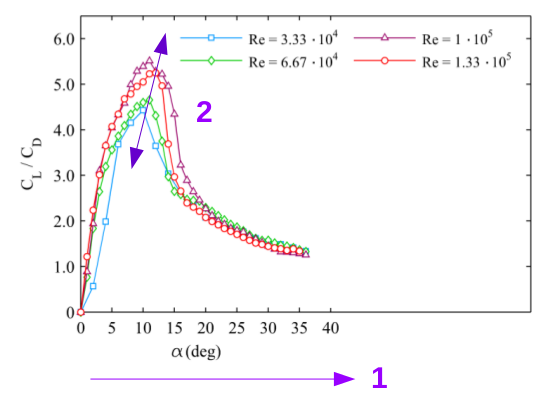Hi experts!
I am trying to qualify the flight performances of a non-powered aircraft in CFD. I have no idea about how it is done in a real wind tunnel, but to calculate the Cl and Cd coefficients of the aircraft, I had to provide an incidence angle (which I assume to be 0° without any thrust), and I had to provide an initial value for the speed - as in the wind tunnel (which I choose arbitrary then, close to what I think it should be from experience) + the weight and surface that I know.
My intent is to determine
-the maximum glide ratio (based on the drag polar curve I guess -the coresponding forward speed (based on the glider polar curve I guess
I am however confused by several aspects:
- Without any thrust, does a gliding object has an incidence of 0°? So how can I deduce the best glide ratio from the drag polar curve which requires different incidence angles to be built ?
- How do we connect the glider polar curve to the drag polar so I can determine the corresponding forward speed?
So to sum up, my question would be : with the possibility to get the Cl and Cd coeffs of my entire gliding object for a given initial angle and speed, what would be the procedure to calculate the maximum glide ratio and corresponding forward speed.
Thanks in advance for any clarification.
I am trying to qualify the flight performances of a non-powered aircraft in CFD. I have no idea about how it is done in a real wind tunnel, but to calculate the Cl and Cd coefficients of the aircraft, I had to provide an incidence angle (which I assume to be 0° without any thrust), and I had to provide an initial value for the speed - as in the wind tunnel (which I choose arbitrary then, close to what I think it should be from experience) + the weight and surface that I know.
My intent is to determine
-the maximum glide ratio (based on the drag polar curve I guess -the coresponding forward speed (based on the glider polar curve I guess
I am however confused by several aspects:
- Without any thrust, does a gliding object has an incidence of 0°? So how can I deduce the best glide ratio from the drag polar curve which requires different incidence angles to be built ?
- How do we connect the glider polar curve to the drag polar so I can determine the corresponding forward speed?
So to sum up, my question would be : with the possibility to get the Cl and Cd coeffs of my entire gliding object for a given initial angle and speed, what would be the procedure to calculate the maximum glide ratio and corresponding forward speed.
Thanks in advance for any clarification.

